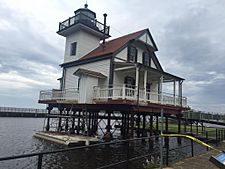Roanoke River Light facts for kids
| Location | Once in Albemarle Sound at the mouth of the Roanoke River; now in Edenton, North Carolina |
|---|---|
| Coordinates | 36°03′22″N 76°36′39″W / 36.056029°N 76.610905°W (current location) |
| Year first lit | 1867 (first light) 1903 (second light) |
| Deactivated | 1941 |
| Foundation | Screw-pile |
| Construction | Cast-iron and wood |
| Tower shape | Square house with a central lantern (first) Square house with a tower at the corner (second) |
| Height | 35 feet (11 m) |
| Original lens | Fourth-order Fresnel lens |
The Roanoke River Lighthouse is a historic lighthouse that is no longer in service. It now sits on the waterfront in Edenton, North Carolina. Originally, it was located in Albemarle Sound at the entrance of the Roanoke River.
This lighthouse is special because it's the only surviving screw-pile lighthouse in the state. A screw-pile lighthouse is built on long metal poles that are screwed deep into the sandy or muddy bottom of the water. The lighthouse has been moved twice, and a copy of an even older version was built in a different town.
Contents
History of the Lighthouse
Long ago, a ship with a light on it, called a lightship, marked this spot starting in 1835. During the Civil War, this ship was captured and later sunk.
The First Lighthouses
The first real lighthouse building was built in 1866. It was a square screw-pile lighthouse, like many others in the area. But in March 1885, it burned down. It was rebuilt that same year. Unfortunately, during the next winter, moving ice in the sound broke its support poles, and the lighthouse fell into the water.
A new lighthouse was built in the same spot in 1887. This one looked different. It was a two-story screw-pile building. Instead of the lamp being in the center of the roof, it was in a tower on the corner of the house. This light used a fourth-order Fresnel lens, a special lens that creates a very bright beam.
Why Was the Lighthouse Moved?
By the 1900s, fewer ships were passing through the area. In 1941, the lighthouse was officially retired, but it was left standing in the water. It was empty for many years.
In 1955, a local man named Elijah Tate bought the lighthouse from the Coast Guard for only $10. He had bought two other lighthouses, but they were destroyed when he tried to move them. So, he sold the Roanoke River Lighthouse to Emmett Wiggins, a tugboat operator.
Wiggins had a clever idea for moving the lighthouse. He used a large military boat called a Landing Craft Infantry (LCI). He floated the boat under the lighthouse and then pumped the water out of the LCI. As the boat rose, it lifted the entire lighthouse off its foundation. The lighthouse was then moved to the shore near Edenton, where it stayed for over 50 years. Mr. Wiggins lived in it from 1960 until he passed away in 1995.

Building a Replica
A museum in the nearby town of Plymouth wanted to buy the original lighthouse from Mr. Wiggins. After he died, his family asked for a million dollars, which the museum couldn't afford.
Instead, the museum decided to build an exact copy of the earlier 1866 lighthouse. They used old plans to build it. The replica was finished in 2003 and stands near the museum in Plymouth.
Restoration and a New Home
In 2007, the Edenton Historical Society bought the original 1887 lighthouse for $225,000. On May 23, 2007, it was moved by a barge to the town's waterfront.
In 2009, the state of North Carolina gave $1.2 million to help fix up the lighthouse. But when workers were preparing the new site, they discovered that the ground was polluted with oil from a company that used to be there. Because of this, the town decided to place the lighthouse permanently over the water instead of on land.

The restoration work began in 2010. The lighthouse got a new roof, and all its windows and doors were repaired. The inside was also restored with furniture from the time period when the lighthouse was active. The project was completed in 2014.
Today, the Roanoke River Lighthouse is part of Historic Edenton, a group of historic sites you can visit. Other sites include the James Iredell House, the Barker House, and the Cupola House.

